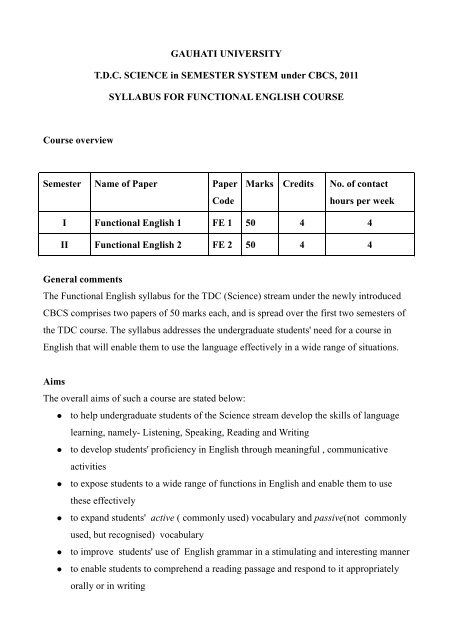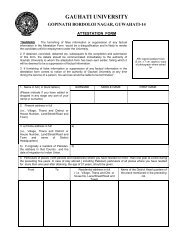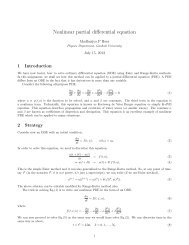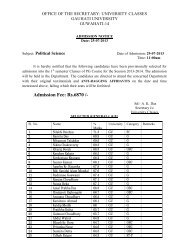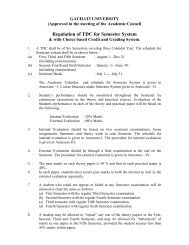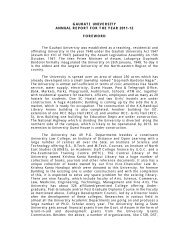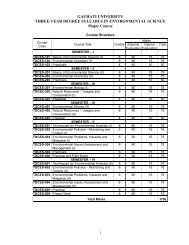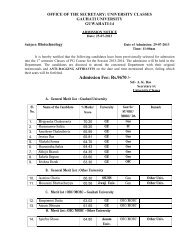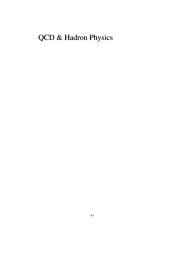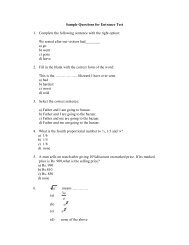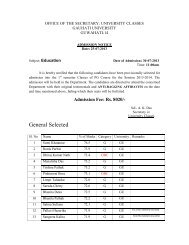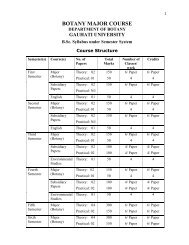functional english course syllabus - Gauhati University
functional english course syllabus - Gauhati University
functional english course syllabus - Gauhati University
Create successful ePaper yourself
Turn your PDF publications into a flip-book with our unique Google optimized e-Paper software.
GAUHATI UNIVERSITYT.D.C. SCIENCE in SEMESTER SYSTEM under CBCS, 2011SYLLABUS FOR FUNCTIONAL ENGLISH COURSECourse overviewSemester Name of Paper PaperCodeMarks CreditsNo. of contacthours per weekI Functional English 1 FE 1 50 4 4II Functional English 2 FE 2 50 4 4General commentsThe Functional English <strong>syllabus</strong> for the TDC (Science) stream under the newly introducedCBCS comprises two papers of 50 marks each, and is spread over the first two semesters ofthe TDC <strong>course</strong>. The <strong>syllabus</strong> addresses the undergraduate students' need for a <strong>course</strong> inEnglish that will enable them to use the language effectively in a wide range of situations.AimsThe overall aims of such a <strong>course</strong> are stated below:• to help undergraduate students of the Science stream develop the skills of languagelearning, namely- Listening, Speaking, Reading and Writing• to develop students' proficiency in English through meaningful , communicativeactivities• to expose students to a wide range of functions in English and enable them to usethese effectively• to expand students' active ( commonly used) vocabulary and passive(not commonlyused, but recognised) vocabulary• to improve students' use of English grammar in a stimulating and interesting manner• to enable students to comprehend a reading passage and respond to it appropriatelyorally or in writing
• to help students develop their proficiency in Written English for academic and otherpurposes• to train students in using Spoken English in a variety of real-life situations• to make students aware of the degrees of appropriateness in the use of English informal, semi-formal and informal situationsThe TextbookJones, Leo (1998) Cambridge Advanced English: Student's Book New Delhi:Cambridge <strong>University</strong> PressThis book has been chosen for the B.Sc. Functional English <strong>course</strong> to give studentspractice in various English language skills. This textbook is to be used for the entire <strong>course</strong>,which is spread over the first two semesters of the TDC Science programme.Teacher’s BookJones, Leo (1998) Cambridge Advanced English: Teacher’s Book New Delhi: Cambridge<strong>University</strong> PressThis book is prescribed as a guide for teachers as it contains instructions and notes on usingthe classroom activities effectively. It also contains transcripts of listening exercises forteachers to use as an alternative to audio cassettes and CDsA new approachThe <strong>syllabus</strong> and textbook represent a new approach to the teaching of English at theundergraduate level. An essential feature of this approach is experiential learning, where thefocus is on self learning through classroom activities that involve students in pairwork/group work. The Teacher’s Book (page 14) describes the advantage of using such anapproach for language development. In this model of language teaching, the teacher plays akey role as ‘classroom manager’, encouraging students to actively engage in the textualactivities individually, and with peers. Research suggests that this motivates and encouragesstudents to communicate spontaneously in real life situations, both orally and in writing.
These sections will not be included in the written examination.All the other sections will comprise the External component, and students will be testedthrough an end-of-semester written examination. Questions for this component should be setfrom the relevant portions in these sections (and should exclude sub-sections engagingstudents in oral activities).For the sections on Listening, the teacher will find the transcripts in the Teacher’s book.These activities are meant to be practised in the class as part of the unit activities. Thesesections on Listening will not be tested separately.AdaptationMost of the thematic content of the language material reflects the global context of the useof English. While familiarity of students with such contexts is considered to be desirable,teachers should feel free to adapt the language material in various sections to suit the localcontext and the background of the learner (e.g. sections 5.5, 11.5 etc.)Course distributionAs Cambridge Advanced English: Student's Book is a comprehensive <strong>course</strong> that isdesigned to develop students’ proficiency in English at the undergraduate level, it is theprescribed textbook for the entire Functional English <strong>course</strong>, to be taught both in the Firstand Second Semesters.The <strong>syllabus</strong> for Functional English 1 in First Semester will comprise Units 1 to 12, whilethe <strong>syllabus</strong> for Functional English 2 in Second Semester will comprise Units 13 to 24 ofthe book.Suggested for further readingSeely, John (1998) The Oxford Guide to Writing and Speaking Oxford: Oxford <strong>University</strong>Press
SEMESTER 1: FUNCTIONAL ENGLISH 1 (FE 1)SyllabusTextbook: Cambridge Advanced English: Student’s BookUnits 1- 12Section Component Assessment Marks Credits No. of contacthours per weekIVocabulary and WordStudyExternal: 80 % 7 4 4II Reading 10IIIWriting(i) Writing(ii) CreativeWriting10IV Grammar 8V Functions 5VICommunicationActivitiesInternal: 20% 6VII Discussions Activities 450 4 4Section I: Vocabulary and Word Study7 MarksObjectives:• to encourage students to expand their active vocabulary• to increase their range of expression to improve their writing skills• to develop a sensitivity towards the use of words in appropriate contexts and
situations• to develop an awareness of the connotations of different vocabulary itemsTEACHING POINTSUNIT SECTIONSSynonyms and their force 2.6Words easily confused 4.4Using abbreviations 6.4Forming adjectives 8.5Descriptive adjectives (personalities) 10.3Using synonyms and opposites-1 12.5Section II: Reading10 MarksObjectives• To improve students' reading skills by giving them practice in the subskills ofReading• To enable them to appreciate the implications and style of a text• To encourage them to deduce meanings from the context• To enable to understand information presented graphicallyTEACHING POINTSUNIT SECTIONSSkimming for general idea 5.4, 7.1, 11.2Scanning for specific informationSame as aboveGuessing meanings of unfamiliar words from the context 3.3, 5.1, 11.2Reading and note taking 1.3,Predicting content from clues such as titles, first 7.1
paragraphs, key words etc.Appreciating content and style 9.1Appreciating the organizing principles of a text 5.4Section III: Writing10 Marks(i) Effective WritingObjectives:• to develop useful practical techniques which will enable students tocommunicate effectively in writing• To teach them planning and writing of reports, essays, narratives,formal/informal letters and other compositions• To develop the skills of describing processes• To provide remedial work for students who need to improve their writing skillsTEACHING POINTSUNIT SECTIONSJoining sentences 1.4Punctuation 3.5Making notes 5.5Using appropriate language 7.3Building paragraphs 9.4Style, tone and content 11.5(ii) Creative writingObjectives:• to enable students to express themselves creatively through writing
• to enable them to choose appropriate styles to communicate with specificreaders• to develop their awareness of variations in style in writing, ranging from lightto serious topicsTOPICSUNIT SECTIONSNarrative or discursive essay/article 1.5, 9.5Writing a film review 3.6Describing a process 5.7Personal and business letters 7.7Life and achievements 11.6Section IV: Grammar8 MarksObjectives:• to help students revise the main problem areas of English Grammar• to enable them to recognise differences in meaning through the use ofdifferent grammatical items• to identify and remedy the common errors in English• to enable them to use verbs and idioms in appropriate contextsTEACHING POINTSUNIT SECTIONSSimple past, present perfect and past perfect 2.3Simple+ progressive aspect 4.3Articles 6.3Past tenses 8.3Modal verbs 10.2Conditional Sentences 12.3Verbs and Idioms 1.6, 2.7, 3.7, 4.7, 5.8, 6.5, 7.8, 8.7, 9.6, 10.5,11.7, 12.6
Section V: Functions5 MarksObjectives:• to improve students' command of spoken English by practicing the <strong>functional</strong>language needed in different situations• to develop their sensitivity to degrees of appropriateness in their use of English• to extend their range of expressions in EnglishTEACHING POINTSUNIT SECTIONSExpressing reactions 2.5Appropriateness 4.5Giving a presentation 5.2Giving an opinion 6.2Different styles 7.4Spoken and written English 8.6Describing people 12.4Section VI: Communication Activities6 MarksObjectives:• to give students an opportunity to use their English in the class in interestingcommunicative activities and produce meaningful written work• to integrate different language skills• to encourage them to improve their English outside the class by readingwidely and practising using English with othersTEACHING POINTSUNIT SECTIONSCommunication activities 2.4, 5.6, 11.4Section VII: Discussion Activities4 MarksObjectives
• to encourage each student to speak• to familiarise the students with useful interactional expressions needed for :1. beginning a discussion2. entering a discussion (at a subsequent stage)3. interrupting a discussion without giving offence4. changing your mind in the <strong>course</strong> of a discussion5. summing up a discussion• to give each student the opportunity to express their opinion on various issuesTeaching PointsDiscussion opportunities are to be found in every unit. These units contain a variety ofquestions that are expected to promote exchange of views.
SEMESTER 2: FUNCTIONAL ENGLISH 2 (FE 2)SyllabusTextbook: Cambridge Advanced English: Student’s BookUnits 13 – 24Section Component Assessment Marks Credits No. of contacthours per weekIVocabulary and WordStudyExternal: 80 % 7 4 4II Reading 10IIIWriting(i) Writing(ii) CreativeWriting10IV Grammar 8V Functions 5VICommunicationActivitiesInternal: 20% 6VII Discussions Activities 450 4 4Section I: Vocabulary and Word Study7 MarksObjectives:• to encourage students to expand their active vocabulary• to increase their range of expression to improve their writing skills• to develop a sensitivity towards the use of words in appropriate contexts and
situations• to develop an awareness of the connotations of different vocabulary itemsTEACHING POINTSUNIT SECTIONSUsing prefixes 18.4Compound Words 20.4British and American English 14.4Using synonyms and opposites-2 16.5Making an emphasis 22.5Topic-based vocabulary/word study 13.1, 15.1, 16.1, 17.1, 18.1, 19.1, 20.1, 21.1,22.1, 23.1Section II: Reading10 MarksObjectives• To improve students' reading skills by giving them practice in the subskills ofReading• To enable them to appreciate the implications and style of a text• To encourage them to deduce meanings from the context• To enable to understand information presented graphicallyTEACHING POINTSUNIT SECTIONSSkimming for general idea 13.3, 14.1, 15.2, 15.6Scanning for specific informationSame as aboveGuessing meanings of unfamiliar words from the context 13.3, 17.2, 22.3, 23.5 etcReading and note taking 21.2Predicting content from clues such as titles, first 17.2
paragraphs, key words etc.Appreciating content and style 17.2Section III: Writing10 Marks(ii) Effective WritingObjectives:• to develop useful practical techniques which will enable students tocommunicate effectively in writing• To teach them planning and writing of reports, essays, narratives,formal/informal letters and other compositions• To develop the skills of describing processes• To provide remedial work for students who need to improve their writing skillsTEACHING POINTSUNIT SECTIONSJoining sentences 13.4Sequencing ideas 15.3Expressing feelings 17.5Word order 19.3Semantic markers 21.4A good introduction and conclusion 23.4(iii)Creative writing:Objectives:• to enable students to express themselves creatively through writing• to enable them to choose appropriate styles to communicate with specificreaders
Objectives• to encourage each student to speak• to familiarise the students with useful interactional expressions needed for :(i) beginning a discussion(ii) entering a discussion (at a subsequent stage)(iii) interrupting a discussion without giving offence(iv) changing your mind in the <strong>course</strong> of a discussion(v) summing up a discussion• to give each student the opportunity to express their opinion on various issuesTeaching PointsDiscussion opportunities are to be found in every unit. These units contain a variety ofquestions that are expected to promote exchange of views.


